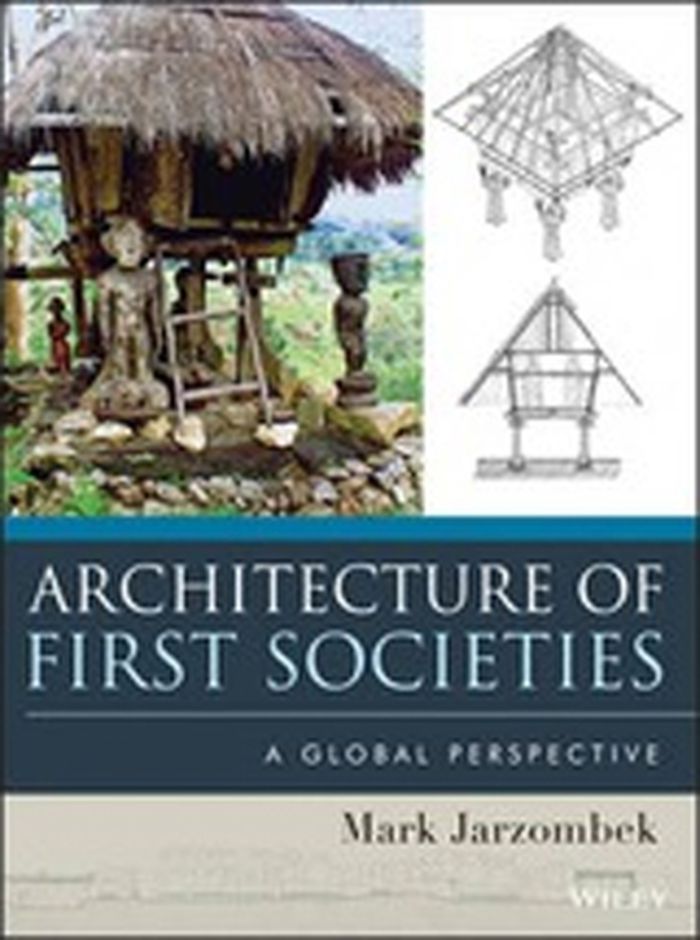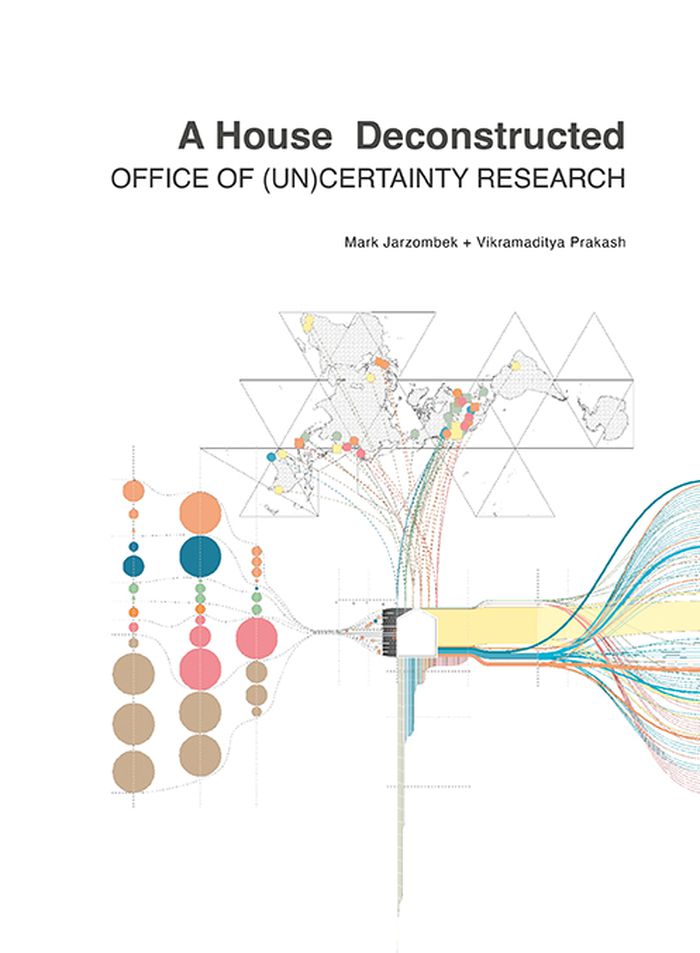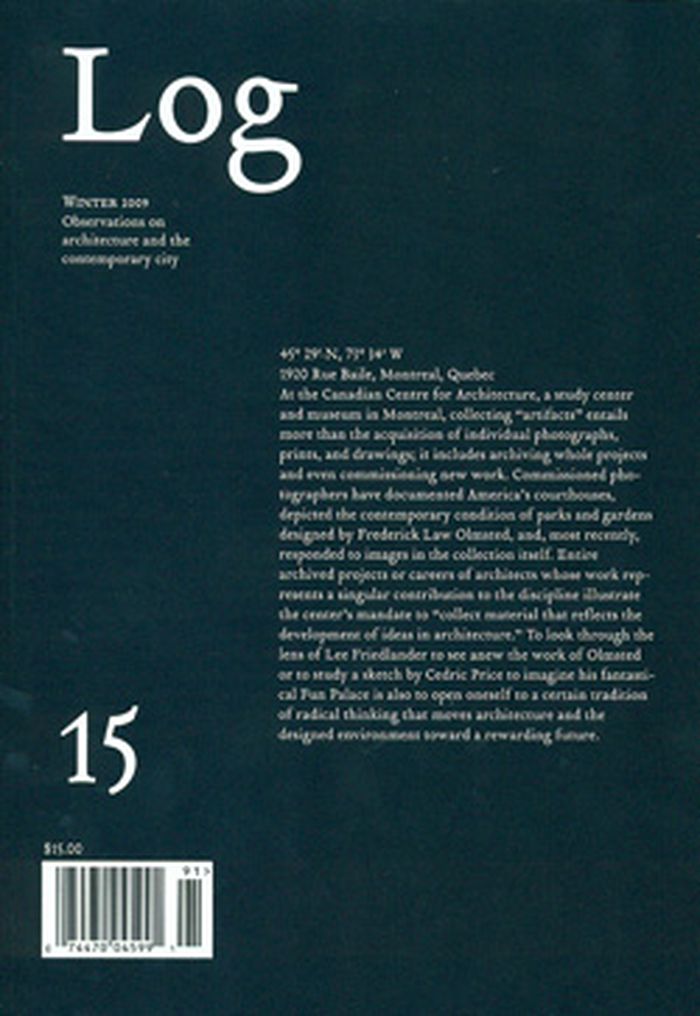books
Description:
ix, 916 pages : illustrations ; 25 cm
Cambridge, MA : SA+P Press : MIT Press, [2013]
A second modernism : MIT, architecture, and the 'techno-social' moment / Arindam Dutta, editor with Stephanie Marie Tuerk, Michael Kubo, Jennifer Yeesue Chuong, Irina Chernyakova.
Actions:
Holdings:
Description:
ix, 916 pages : illustrations ; 25 cm
books
Cambridge, MA : SA+P Press : MIT Press, [2013]
$149.00
(available to order)
Summary:
Starting with the dawn of human society, through early civilizations, to the pre-Columbian American tribes, Architecture of First Societies: A Global Perspective traces the different cultural formations that developed in various places throughout the world to form the built environment. Looking through the lens of both time and geography, the history of early architecture(...)
Architecture of first societies: a global perspective
Actions:
Price:
$149.00
(available to order)
Summary:
Starting with the dawn of human society, through early civilizations, to the pre-Columbian American tribes, Architecture of First Societies: A Global Perspective traces the different cultural formations that developed in various places throughout the world to form the built environment. Looking through the lens of both time and geography, the history of early architecture is brought to life with full-color photographs, maps, and drawings. Drawing on the latest research in archaeological and anthropological knowledge, this landmark book also looks at how indigenous societies build today in order to help inform the past.
History until 1900
$62.00
(available to order)
Summary:
This book ''deconstructs'' a single recently constructed house located in Seattle, WA, in an attempt to recover its backstory. The information is presented along four vectors - atoms, labors, sources and ingredients. Though remarkably detailed, the book contends that a huge proportion of what we ''know'' about the house is unknowable, not because ou epistemological(...)
Architecture Monographs
March 2023
A house deconstructed: Office of (Un)certainty research
Actions:
Price:
$62.00
(available to order)
Summary:
This book ''deconstructs'' a single recently constructed house located in Seattle, WA, in an attempt to recover its backstory. The information is presented along four vectors - atoms, labors, sources and ingredients. Though remarkably detailed, the book contends that a huge proportion of what we ''know'' about the house is unknowable, not because ou epistemological instruments aren't strong enough or calibrated precisely enough, but because things themselves are indeterminate, uncertain.
Architecture Monographs
$114.00
(available to order)
Summary:
The award-winning First Edition of A Global History of Architecture was a publishing event that forever changed the way architectural history is viewed and studied. This Second Edition surpasses the first with a lavish new design, illustrated throughout with drawings and photographs in full color, and even more maps and diagrams detailing global interconnections. The(...)
October 2010
A global history of architecture 2nd edition
Actions:
Price:
$114.00
(available to order)
Summary:
The award-winning First Edition of A Global History of Architecture was a publishing event that forever changed the way architectural history is viewed and studied. This Second Edition surpasses the first with a lavish new design, illustrated throughout with drawings and photographs in full color, and even more maps and diagrams detailing global interconnections. The signature drawings of Francis D.K. Ching are more informative than ever, updated with scale, annotation, and function added where needed. This revision is sure to remain the most relevant book on the topic.
$150.00
(available in store)
Summary:
Spanning from 3,500 BCE to the present, and organized along a global timeline, this unique guide was written by experts in their fields who emphasize the connections, contrasts, and influences of architectural movements throughout history and around the world. Fully updated and revised to reflect current scholarship, this third edition features expanded chapter(...)
April 2017
A global history of architecture, third edition
Actions:
Price:
$150.00
(available in store)
Summary:
Spanning from 3,500 BCE to the present, and organized along a global timeline, this unique guide was written by experts in their fields who emphasize the connections, contrasts, and influences of architectural movements throughout history and around the world. Fully updated and revised to reflect current scholarship, this third edition features expanded chapter introductions that set the stage for a global view, as well as: an expanded section on contemporary global architecture, more coverage of non-Western cultures, particularly South Asia, South East Asia Pre-Columbian America, and Africa. New drawings and maps by the iconic Francis D.K. Ching, as well as more stunning photographs. An updated companion website with digital learning tools and Google Earth mapping service coordinates that make it easier to find sites. Art and architecture enthusiasts, and anyone interested in architectural history, will have 5,000 years of the built environment perpetually at their fingertips with "A global history of architecture, third edition".
books
$32.95
(available to order)
Summary:
Bay by the turn of the century. But in 1912, backed by some of the country’s leading financiers and industrialists, MIT officials purchased an undeveloped tract of land in Cambridge, launching a long and complex review of proposals for a new quadrangle. Based largely on the recommendation of John D. Rockefeller Jr., the commission was awarded to MIT and the École des(...)
Designing MIT: Bosworth's new tech
Actions:
Price:
$32.95
(available to order)
Summary:
Bay by the turn of the century. But in 1912, backed by some of the country’s leading financiers and industrialists, MIT officials purchased an undeveloped tract of land in Cambridge, launching a long and complex review of proposals for a new quadrangle. Based largely on the recommendation of John D. Rockefeller Jr., the commission was awarded to MIT and the École des Beaux-Arts-trained architect William Welles Bosworth, known for his AT Building in Manhattan, and Kykuit, the Rockefeller mansion in Tarrytown, New York. Designing MIT is the first book to detail Bosworth’s challenges in the planning and construction of the Institute’s unique Cambridge campus. Beginning with an examination of the competing project proposals—from Steven Child, an emerging landscape designer and student of Frederick Law Olmstead; Desiré Despradelle, Chairman of the Department of Architecture at MIT and a leading Beaux-Arts stylist; Ralph Adams Cram, noted for his gothic West Point campus; and John Freeman, one of the country’s leading civil engineers—Mark M. Jarzombek provides a captivating cross-section of the architectural debates of the time. Though Bosworth’s considerable social and political finesse enabled him to land the commission and balance varied competing interests, he found his classically oriented vision challenged by engineer John Freeman, proponent of Frederick W. Taylor’s new principle of Scientific Management. However strained, the conflict ultimately resulted in a far more innovative design than either individual approach, employing new European concepts of industrialism, efficiency, and aesthetics in academic structures.
books
November 2004
Commercial interiors, Building types
$15.00
(available in store)
Summary:
Log 15 is a slice through the present, featuring the current work and thinking of some of today’s leading architectural historians and theorists: Barry Bergdoll, Mario Carpo, Jean-Louis Cohen, Beatriz Colomina, Hubert Damisch, Peter Eisenman, Kurt Forster, Mark Jarzombek, Irving Lavin, Sylvia Lavin, Mark Wigley, and Mirko Zardini. Assembled to honor Phyllis Lambert on her(...)
Magazines
March 2009, New York
Log 15, winter 2009: observations on architecture and the contemporary city
Actions:
Price:
$15.00
(available in store)
Summary:
Log 15 is a slice through the present, featuring the current work and thinking of some of today’s leading architectural historians and theorists: Barry Bergdoll, Mario Carpo, Jean-Louis Cohen, Beatriz Colomina, Hubert Damisch, Peter Eisenman, Kurt Forster, Mark Jarzombek, Irving Lavin, Sylvia Lavin, Mark Wigley, and Mirko Zardini. Assembled to honor Phyllis Lambert on her 80th birthday, these essays range from an architectural and archaeological reading of Chris Marker’s post-apocalyptic film La Jetée to Dravidian architecture in India; from Gordon Matta-Clark’s erasure of architecture to the persistence of asphalt; from the influence of Andy Warhol on ambient architecture past and present to the house in the museum and the museum in the house.
Magazines
Perspecta 40
$26.50
(available to order)
Summary:
This fortieth issue of Perspecta--the oldest and most distinguished student-edited architectural journal in America--examines architecture past and present through the lens of the monster. The contributors--a diverse group of scholars, practitioners, and artists--embrace the multitude of meanings this term carries in an attempt to understand how architecture arrived at(...)
Magazines
August 2008, Boston
Perspecta 40
Actions:
Price:
$26.50
(available to order)
Summary:
This fortieth issue of Perspecta--the oldest and most distinguished student-edited architectural journal in America--examines architecture past and present through the lens of the monster. The contributors--a diverse group of scholars, practitioners, and artists--embrace the multitude of meanings this term carries in an attempt to understand how architecture arrived at its present situation and where it may be going. Perspecta 40 represents in itself a kind of monster--a hybrid, jumbled, conflicting amalgamation of work and ideas that looks at the past in new ways and tells of things to come. Contributors: Philip Bernstein, Mario Carpo, Arindam Dutta, Ed Eigen, Mark Gage, Gensler, Marcelyn Gow and Ulrika Karlsson (servo), Catherine Ingraham, Mark Jarzombek, Terry Kirk, Leon Krier, Greg Lynn, John May, John McMorrough, Colin Montgomery, Guy Nordenson, Eeva-Liisa Pelkonen, Emmanuel Petit, Kevin Roche, Yoshiharu Tsukamoto (Atelier Bow-Wow) and Ryuji Fujimura, Michael Weinstock, Claire Zimmerman.
Magazines
books
The education of the architect : historiography, urbanism, and the growth of architectural knowledge
$61.95
(available to order)
Summary:
The authors of these eighteen essays have all been deeply influenced by the philosophy of architecture developed by Stanford Anderson, through his writings and through the teaching programme of the Department of History, Theory, and Criticism of (...)
The education of the architect : historiography, urbanism, and the growth of architectural knowledge
Actions:
Price:
$61.95
(available to order)
Summary:
The authors of these eighteen essays have all been deeply influenced by the philosophy of architecture developed by Stanford Anderson, through his writings and through the teaching programme of the Department of History, Theory, and Criticism of Architecture, which he and Henry Millon founded at MIT over twenty years ago. This "school" of architectural thought views architecture as a world of inquiry and as a discipline anchored in the epistemological bases of contemporary philosophy, especially the philosophy of science. Clear thematic concerns bind the essays together. The essays of the first section, "American Debates," share a deep preoccupation with modernism, its national ideologies, and regional responses in the American context. The contributors to the second section, "European Responses," examine European responses to these American debates. In the third section, "Historiographic Constructs," contributors comment on the writing, interpretation, and uses of architectural history. Contributors to the fourth section, "Urbanisms," grapple with the knotty interdependence of politics and the built environment. In the last section, "Teaching Architecture," four distinguished educators consider the most difficult aspect of the discipline, its pedagogical mandate. Whether historians or architects (and several have trained in both areas), the essayists all share the belief that contemporary concerns about architecture affect the way history is constructed. Because they view architecture as a body of knowledge evolving over time, they have resisted the wholesale espousal or rejection of modernism that has often polarized the examination and practice of architecture in the second half of this century. Contributors: Lawrence Anderson, Hilary Ballon, Micha Bandini, Sibel Bozdogan, Maristella Casciato, Charles Correa, Gail Fenske, Diane Ghirardo, John Habraken, Mark Jarzombek, Royston Landau, Ákos Moravánszky, Carlo Olmo, Nasser Rabbat, Mitchell Schwarzer, Joseph Siry, Nancy Stieber, Danilo Udovicki-Selb.
books
June 1997, Cambridge, Mass.
Architectural Theory





